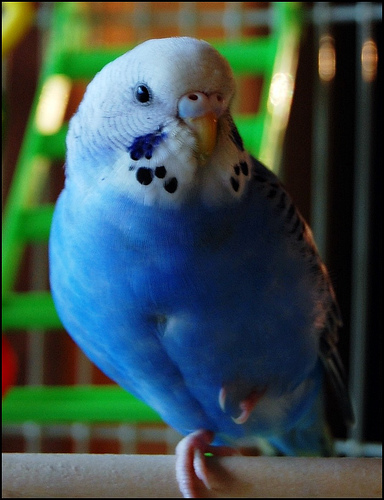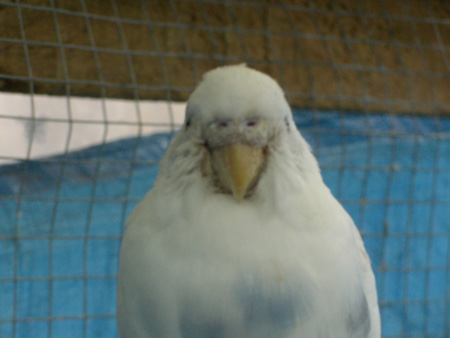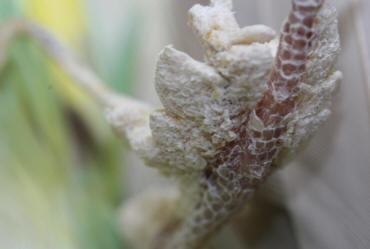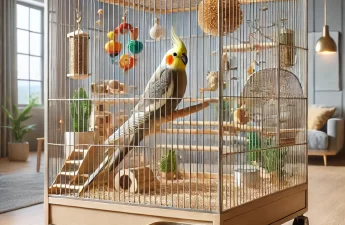The parakeet’s feet and claws are as important to them as our feet our to us. Their feet and claws are important for gripping perches and performing active movements and activity. So making sure that their feet and claws are healthy and well maintained is very important when owning a parakeet.
Ways to Keep Parakeet’s Feet Healthy
There are several steps that can be taken to ensure that the parakeet’s feet and claws are healthy. These steps can prevent problems before they happen. Make sure that there are soft perches for the parakeet as well as a cleaned out cage. Most feet and claw problems can stem from unclean cages. Another step to take is to make sure that the parakeet is being provided a healthy well balanced diet filled with many vitamins and greens. If you are unsure what to feet your parakeet stop by the Parakeet diet page for suggestions.

Common Parakeet Foot Problems
Sometimes no matter how hard you try to prevent a parakeet’s foot problem they occur. Here are some of the most common parakeet foot problems that can occur.
Bumblefoot: Bumblefoot is the most common parakeet foot problem. It is the inflammation or infection of the bottom of the foot. This usually starts out as slight reddening of the skin and can turn into ulcers on the bottom of the parakeet’s feet. If left untreated or ignored the infection can spread and kill the skin around the bottom of the foot and eventually spread to the bone of the parakeet’s leg.
Cause of Bumblefoot usually stem from plastic parakeet perches, sandpaper used around the perches or uncleaned perches that can become a breeding ground for bacteria. Other less common problems can be a vitamin deficiency or other natural cause but these are fairly uncommon.
If a parakeet does develop bumblefoot there are antibiotics and anti-inflammatory medicine that can be prescribed to deal with the reddening and swelling of the skin. Severe cases of bumblefoot might call for the use of bandages to prevent the spread of the infection. These bandages must be changed regularly to ensure that the parakeet’s environment is safe and free of any dirt or potential hazards.
Bumblefoot can take anywhere from a few weeks to months to clear up depending upon the severity of the case.
There are steps that can help you prevent your parakeet from getting bumblefoot. The most important first step is to make sure that the perches are cleaned regular. Other steps include making sure the parakeet is getting a proper diet and try replacing any hard perches with softer perches made of wood or cotton rope.
Scaly Face: A common face and skin problem is known as Scaly Face. This is very common amongst caged parakeets. It is a parasitic attack. The Cnemidocoptes pilae parasite will actually burrow into the skin around the beak and face section causing the scaly face to occur.
Signs of scaly face include fungus growths on the beak, fungus around the legs, eyes and cere or vent areas. One or more areas can be effected by scaly face.

Scaly face is very treatable. If the parakeet has a slight case of scaly face it can be treated by the use of dettol disinfectant. In which the parakeet’s infected area will need to be wiped down 3 times a day for the first three days, then two times a day for up to three weeks until the infection has gone down. Dettol is applied to a Qtip and used to wiped down the effected areas. Dettol will also be used to clean the cage, perches and other areas of the parakeet’s cage to clean up the mites that exist. Dettol is very harmless to the birds and the most effective treatment of getting rid of those mites.
Severe case of scaly face will be treated with the medication, ivermectin and can only be obtained by a vet.
Scaly Legs: Sometimes a parasite might start to attack your parakeet’s legs. These attacks cause huge skin protrusions and as a result can cause scales to form on the legs. Dry flaky skin and small red dots caused by the burrowing mites can also be other signs of this parasite.
Treatment for this is the same as Scaly face. Severe cases will be treated with ivermectin or dettol which can help clean up the parasites.




